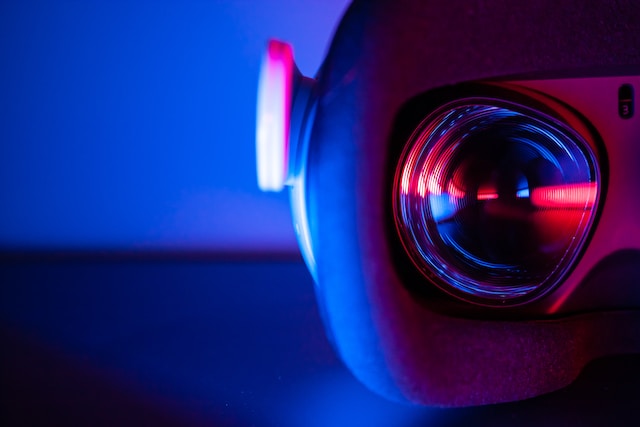Virtual reality has been a buzzword for quite some time now, and it’s not just limited to the gaming industry anymore. The technology of virtual reality is rapidly evolving and has made its way into various fields, including healthcare. Virtual reality in healthcare is still a relatively new concept but holds immense potential to revolutionize the future of medicine. From training medical professionals to treating patients, virtual reality can provide an immersive experience that traditional methods cannot match. Let us delve deeper into the world of virtual reality and explore its potential in healthcare!
What is Virtual Reality?
Virtual reality is a simulated environment that can be experienced by an individual through a headset, which creates a 3D world. The user can interact with this virtual world and experience it as if they were physically present in it. Virtual reality technology has come a long way since its inception, thanks to advancements in wearable technology.
The concept of virtual reality originated from computer games but soon found its place in other industries, including healthcare. With the use of advanced VR headsets, users can immerse themselves into realistic simulations for various purposes like medical training or patient treatment.
Virtual reality operates on the principle of tracking the movements of the user’s head and eyes and rendering life-like images based on those movements. This real-time adaptation allows for an immersive experience for the user where they feel like they are part of another world entirely.
In healthcare, virtual reality is being used to simulate surgeries and procedures so that medical professionals can practice their skills without putting actual patients at risk. Furthermore, VR is also proving useful as therapy for patients suffering from mental health issues such as anxiety disorders or phobias.
Virtual reality offers immense potential not just in gaming but across many industries including healthcare where it could potentially revolutionize how we diagnose illnesses and train new doctors.
How Does Virtual Reality Work?
Virtual Reality (VR) is a technology that allows users to experience digital environments by simulating the physical presence of objects and entities in a 3D space. The core components of VR include hardware devices and software applications, each working together seamlessly to provide an immersive experience.
The hardware devices used in VR typically include a headset, controllers, sensors or cameras, and computing equipment. The headset is worn on the head like goggles and has built-in displays that project images directly into the user’s eyes. Controllers are handheld devices used to interact with virtual objects.
Software applications render realistic 3D graphics in real-time through complex algorithms designed for specific purposes such as gaming or healthcare simulations. These applications also utilize input from sensors or cameras to track body movements and adjust certain aspects of the environment accordingly.
In summary, Virtual Reality works by creating an artificial world using advanced hardware devices such as headsets and controllers along with specialized software applications that simulate reality in real-time. These technologies work together seamlessly to create immersive experiences that can have numerous benefits across different industries including healthcare, education, entertainment among others.
Benefits of Virtual Reality in Healthcare
Virtual reality (VR) technology is revolutionizing the healthcare industry by offering a range of benefits to patients, doctors, and medical professionals. Here are some key advantages of using VR in healthcare:
Firstly, virtual reality technology can help alleviate pain and anxiety in patients during medical procedures. By immersing the patient in a calming environment through VR headsets or goggles, they become less aware of their surroundings and often require less anesthesia.
Furthermore, VR has proven to be an effective tool for therapy and rehabilitation. Patients with physical disabilities or injuries can use VR simulations to practice movements and improve their motor skills without risking additional injury.
Another benefit of VR is that it allows medical professionals to better understand complex anatomical structures by providing them with an immersive 3D visualization of organs, bones or tissues before surgery.
Additionally, virtual reality training programs can help prepare surgeons for real-life operations by allowing them to rehearse complicated procedures beforehand on virtual patients.
As telemedicine continues its growth trajectory due to COVID-19 pandemic preventive measures; Virtual Reality provides opportunities for remote diagnosis & treatment sessions with higher level of interactivity between physicians & patients; thus improving access to quality care especially among rural/remote populations.
These are just few examples how Virtual Reality has vast potential in contributing toward advances within healthcare system at large scale!
Challenges of Virtual Reality in Healthcare
While virtual reality (VR) shows great potential in healthcare, there are also notable challenges to consider. One of the main hurdles is the high cost of equipment and technology needed for VR implementation. Healthcare facilities will need to invest significantly in VR hardware and software, which can be a financial strain.
Another challenge is ensuring patient safety during VR experiences. Motion sickness or discomfort caused by wearing heavy headsets may lead to adverse effects on patients’ health conditions. Additionally, patients with certain medical conditions such as epilepsy or heart disease might not be able to tolerate or use this technology.
Furthermore, integrating virtual reality into existing healthcare systems presents logistical issues like data privacy and security risks that must be addressed when implementing new tools for patient care.
Training medical staff on how to properly utilize virtual reality technology can pose another challenge since it requires additional time and resources from already busy schedules.
Despite these obstacles, many experts believe that the benefits of using VR in healthcare outweigh its limitations if used appropriately according to evidence-based research protocols.
Conclusion
The potential of virtual reality in healthcare cannot be underestimated. As technology continues to advance and become more accessible, it is likely that virtual reality will play an increasingly important role in improving patient outcomes and enhancing medical training.
From reducing pain during procedures to providing a safe space for therapy sessions, the benefits of this technology are clear. However, as with any new development in healthcare, there are challenges that must be addressed before it can reach its full potential.
The key challenge facing virtual reality is accessibility. While the cost of VR headsets has decreased significantly in recent years, they are still relatively expensive for many hospitals and clinics. Additionally, not all patients or medical professionals may have access to the necessary equipment or technical expertise required to use VR effectively.
Despite these challenges, there is no doubt that virtual reality has enormous potential within healthcare settings. By continuing to invest in research and development while addressing challenges around accessibility and adoption rates by both practitioners and patients alike , we can expect further breakthroughs that will revolutionize medicine as we know it today.








